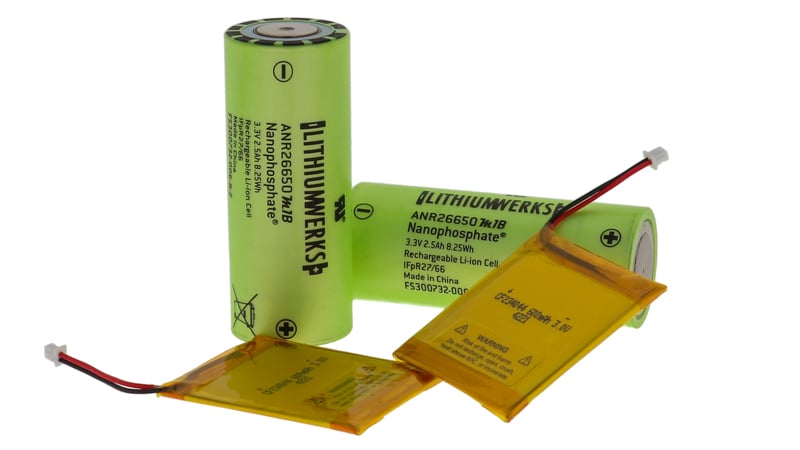When talking about custom battery packs for portable devices, the most common type mentioned has been lithium-based chemistries. Lithium-based batteries provide high-energy density and a light weight for applications, making them suitable for portable electronics that require long battery life to perform high-speed functions.
As for rechargeable batteries, special steps are taken with lithium-based batteries due to their chemistry being unstable than other battery types, such as NiCad and NiMH. They must undergo rigorous testing per UN/DOT 38.3 specifications as well as have battery management systems.
There are many types of lithium batteries available to customers. The two types that are most used are lithium-ion and lithium iron phosphate. When deciding on which battery chemistry to use, understanding the differences between these lithium-based batteries such as energy density, operation, and safety, can have a significant impact on your application.
Differences in Battery Chemistry
Lithium-ion batteries are quite common in smartphones, laptops, and other devices. There are two types of chemistries that a lithium-ion battery may possess. One consists of a graphite anode with a lithium manganese oxide cathode. The other may also have a graphite anode but with a lithium cobalt oxide cathode.
Lithium iron phosphate (LiFePO4) has a graphite anode and an iron phosphate cathode. They are a newer technology than lithium-ion, as they are mostly found as EV car batteries and solar-powered lights.
Both chemistries work in the same manner. The lithium ions will begin to move from the positive electrode to the negative electrode, and vice versa, during charging and discharging cycles.

Example of lithium-ion and lithium iron phosphate (LiFePO4) batteries.
Differences in Energy Density
For energy density, there are big differences between these two battery chemistries. Both offer good density when compared to other chemistries. However, lithium-ion has a higher energy density. This battery type offers 150/200 Wh/kg for applications.
In comparison, lithium iron phosphate has an energy density of 90/120 Wh/kg. The battery still is a good choice when it comes to electronics that require batteries with higher levels of power. Yet the lithium-ion in this case is specifically chosen for high-speed electronics.
One thing to keep in mind is that lithium iron phosphate has a better discharge rate than lithium-ion. They discharge at 25C, especially at higher temperatures, and can go up to 1,000 to 10,000 charge/discharge cycles. As the capacity becomes reduced, the lithium iron phosphate experiences lower degradation. For lithium-ion, the discharge rate is about 10C as it can have about 500 to 1,000 charge/discharge cycles and can degrade faster at higher temperatures from the device's components.
Battery Operation and Storage
Both types of batteries have a long life when used and handled properly. Lithium-iron phosphate can handle higher temperatures as they have a nominal voltage of 3.20 to 3.30 and a 2.5-3.65V/cell operating range. These batteries have stable chemistry to where it does not experience as many negative impacts from overcharging or short circuits. It has an exceptionally long shelf-life of 350 days.
Lithium-ion batteries have a shorter shelf-life of 300 days when compared to the other. Its chemistry is a bit more unstable when experiencing higher temperatures, short circuits, and overcharging. The operating range of lithium-ion batteries is 3.0 to 4.2V/cell for lithium manganese oxide and a nominal voltage of 3.70V. Lithium cobalt oxide batteries have a nominal voltage of 3.60V and the same operating range of 3.0 to 4.2V/cell.
Thermal Runaway and Safety
Lithium iron phosphate is a safer chemistry than lithium-ion. It has exceptional thermal and chemical stability at higher temperatures and consistent power at room temperatures. It is rare for lithium iron phosphate batteries to experience thermal runaway. The battery normally stays cool as it will not explode or catch fire during overcharging or when experiencing overheating. In addition, lithium iron phosphate is not toxic. Disposal of this chemistry is easier and more cost-effective for customers.
For these reasons, EV car manufacturers look at lithium iron phosphate for electric motors. This type of battery chemistry is also used for medical devices and military devices as it is suitable for any application that requires long battery life and chemistry stability where safety is paramount.
Lithium-ion chemistries are unstable due to their higher energy densities. This chemistry will experience thermal runaway as it heats up faster during charging. This increase of heat can occur even when the lithium-ion battery is used at normal room temperatures as it can absorb the heat around it from the other working electronics inside the device. Also, lithium-ion batteries containing cobalt are considered hazardous due to the fact that cobalt is a toxic substance. It can cause severe medical issues as well as skin and eye irritation. Precautions must be taken for disposal, which can increase the manufacturing costs for customers.
Transportation Restrictions and Certifications
Due to both battery chemistries containing lithium and lithium-ion, all lithium-based batteries must undergo UN/DOT 38.3 shipping testing and certification for the safe transport of the batteries to different locations. This certification will allow the transport of lithium and lithium-ion batteries for air freight shipment. In addition, U.S. DOT 49 CFR regulations go into greater detail regarding how lithium and lithium-ion batteries must be packaged and shipped for international and interstate transportation.
Customers should keep in mind the industry and timelines regarding the testing of their lithium-based batteries. Different industries may require specific certifications from regulatory bodies. Testing times can fluctuate depending on the testing location, as it may take anywhere from 3 weeks up to 12 weeks for the testing to be completed.
Battery Cell Forms
Both lithium-based batteries are available in two types of cell forms: prismatic and cylindrical, based on the size of the application and the number of cells that will be required to reach the desired voltage.
Two of the most popular cylindrical cells for lithium-ion batteries are the 18mm x 65mm batteries with 16.5mL volume (18650 format) and the 21mm x 70mm batteries with 24mL volume (21700 format). The 17650 cylindrical battery cell format is also available for the lithium iron phosphate batteries as they also come in the smaller 26650 formats of 26mm x 65mm.
Lithium iron phosphate batteries are also becoming more popular in prismatic cell form. These large batteries have a 50-Ah range up to 100-Ah range. These large batteries are often used in stationary equipment, industrial equipment, or electric vehicles.
Li-ion & LiFePO4 Supported Markets
Here's a comparison of the markets supported by Lithium-Ion (Li-ion) and Lithium Iron Phosphate (LiFePO4) batteries:
| Application Area | Lithium-Ion (Li-ion) Batteries | Lithium Iron Phosphate (LiFePO4) Batteries |
|---|---|---|
| Consumer Electronics | They are widely used in smartphones, laptops, tablets, and cameras due to their high energy density, which allows longer usage times in compact devices. | Less commonly used in consumer electronics because of their lower energy density, which can result in larger and heavier batteries. |
| Electric Vehicles (EVs) | Preferred in EVs that require longer ranges, as their higher energy density supports extended driving distances. However, they are more prone to overheating and have a shorter lifespan compared to LiFePO4 batteries. | Increasingly used in EVs, especially in applications where safety and longevity are prioritized over range. Their excellent thermal stability and longer cycle life make them suitable for buses, trucks, and other vehicles where space is less of a constraint. |
| Renewable Energy Storage | Utilized in home energy storage systems where space is limited, benefiting from their compact size and higher energy density. | Gaining popularity in solar and wind energy storage systems due to their long cycle life, safety, and ability to handle high charge and discharge currents, despite requiring more space for the same energy storage. |
| Medical Devices | Commonly used in portable medical equipment where compact size and high energy are essential. | Chosen for medical applications that demand high safety standards and reliability, such as stationary medical equipment and backup power supplies. |
| Industrial Applications | Applied in tools and equipment that benefit from high energy density, though thermal management is a consideration. | Preferred in industrial settings requiring robust and durable power sources, including backup power systems and machinery that operate in high-temperature environments. |
This comparison highlights how the distinct characteristics of Li-ion and LiFePO4 batteries make them suitable for different applications across various industries.
Summary
When it comes to choosing a lithium-based battery for applications, lithium-ion and lithium iron phosphate are two choices when looking for high-powered batteries that also offer a long-life span. For any application where safety is an issue, lithium iron phosphate batteries are a good choice. For portable devices that require higher energy densities, lithium-ion batteries are typically used. Selecting the right cell chemistry and cell form will allow your application to run optimally for many years.
Key Takeaways:
- Energy Density & Performance:
- Lithium-ion batteries have a higher energy density (150-200 Wh/kg), making them ideal for portable electronics and high-speed applications.
- Lithium iron phosphate (LiFePO4) batteries have a lower energy density (90-120 Wh/kg) but offer better discharge rates and longer cycle life.
- Safety & Thermal Stability:
- Lithium iron phosphate is a safer chemistry with greater thermal stability, making it suitable for medical, military, and EV applications.
- Lithium-ion batteries are more prone to thermal runaway, overheating, and require stricter safety precautions.
- Battery Lifespan & Storage:
- LiFePO4 batteries can last up to 10,000 charge/discharge cycles, while lithium-ion typically lasts 500-1,000 cycles.
- LiFePO4 batteries also have a longer shelf-life (350 days vs. 300 days for lithium-ion).
- Transportation & Regulatory Compliance:
- Both battery types require UN/DOT 38.3 certification for safe transportation, but lithium-ion batteries have stricter disposal regulations due to the presence of cobalt.
- Industry-specific certifications and testing timelines (3-12 weeks) should be factored into production schedules.
- Market Applications & Form Factors:
- Lithium-ion is preferred for consumer electronics, high-performance devices, and portable applications.
- Lithium iron phosphate is ideal for EVs, industrial equipment, and stationary energy storage, often available in prismatic and cylindrical cell forms.
















